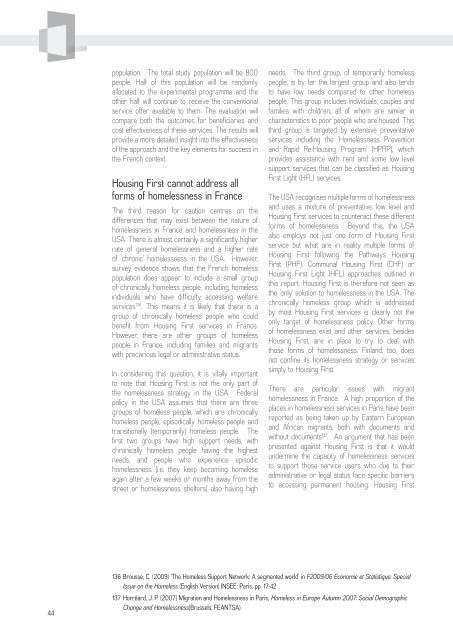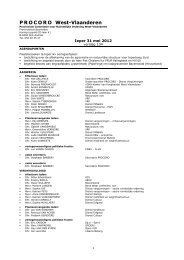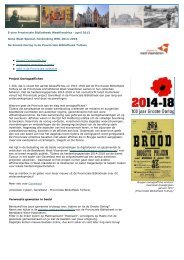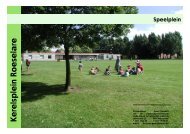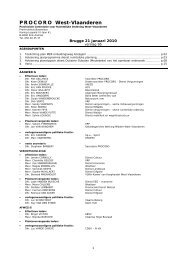Housing First - Provincie West-Vlaanderen
Housing First - Provincie West-Vlaanderen
Housing First - Provincie West-Vlaanderen
You also want an ePaper? Increase the reach of your titles
YUMPU automatically turns print PDFs into web optimized ePapers that Google loves.
population. The total study population will be 800people. Half of this population will be randomlyallocated to the experimental programme and theother half will continue to receive the conventionalservice offer available to them. The evaluation willcompare both the outcomes for beneficiaries andcost effectiveness of these services. The results willprovide a more detailed insight into the effectivenessof the approach and the key elements for success inthe French context.<strong>Housing</strong> <strong>First</strong> cannot address allforms of homelessness in FranceThe third reason for caution centres on thedifferences that may exist between the nature ofhomelessness in France and homelessness in theUSA. There is almost certainly a significantly higherrate of general homelessness and a higher rateof ‘chronic’ homelessness in the USA. However,survey evidence shows that the French homelesspopulation does appear to include a small groupof chronically homeless people, including homelessindividuals who have difficulty accessing welfareservices 136 . This means it is likely that there is agroup of chronically homeless people who couldbenefit from <strong>Housing</strong> <strong>First</strong> services in France.However, there are other groups of homelesspeople in France, including families and migrantswith precarious legal or administrative status.In considering this question, it is vitally importantto note that <strong>Housing</strong> <strong>First</strong> is not the only part ofthe homelessness strategy in the USA. Federalpolicy in the USA assumes that there are threegroups of homeless people, which are chronicallyhomeless people, episodically homeless people andtransitionally (temporarily) homeless people. Thefirst two groups have high support needs, withchronically homeless people having the highestneeds, and people who experience episodichomelessness (i.e. they keep becoming homelessagain after a few weeks or months away from thestreet or homelessness shelters) also having highneeds. The third group, of temporarily homelesspeople, is by far the largest group and also tendsto have low needs compared to other homelesspeople. This group includes individuals, couples andfamilies with children, all of whom are similar incharacteristics to poor people who are housed. Thisthird group is targeted by extensive preventativeservices including the ‘Homelessness Preventionand Rapid Re-<strong>Housing</strong> Program’ (HPRP), whichprovides assistance with rent and some low levelsupport services that can be classified as <strong>Housing</strong><strong>First</strong> Light (HFL) services.The USA recognises multiple forms of homelessnessand uses a mixture of preventative, low level and<strong>Housing</strong> <strong>First</strong> services to counteract these differentforms of homelessness. Beyond this, the USAalso employs not just one form of <strong>Housing</strong> <strong>First</strong>service but what are in reality multiple forms of<strong>Housing</strong> <strong>First</strong> following the Pathways <strong>Housing</strong><strong>First</strong> (PHF), Communal <strong>Housing</strong> <strong>First</strong> (CHF) or<strong>Housing</strong> <strong>First</strong> Light (HFL) approaches outlined inthis report. <strong>Housing</strong> <strong>First</strong> is therefore not seen asthe ‘only’ solution to homelessness in the USA. Thechronically homeless group which is addressedby most <strong>Housing</strong> <strong>First</strong> services is clearly not theonly target of homelessness policy. Other formsof homelessness exist and other services, besides<strong>Housing</strong> <strong>First</strong>, are in place to try to deal withthose forms of homelessness. Finland, too, doesnot confine its homelessness strategy or servicessimply to <strong>Housing</strong> <strong>First</strong>.There are particular issues with migranthomelessness in France. A high proportion of theplaces in homelessness services in Paris have beenreported as being taken up by Eastern Europeanand African migrants, both with documents andwithout documents 137 . An argument that has beenpresented against <strong>Housing</strong> <strong>First</strong> is that it wouldundermine the capacity of homelessness servicesto support those service users who due to theiradministrative or legal status face specific barriersto accessing permanent housing. <strong>Housing</strong> <strong>First</strong>44136 Brousse, C. (2009) ‘The Homeless Support Network: A segmented world’ in F2009/06 Economie et Statistique: SpecialIssue on the Homeless (English Version) INSEE: Paris, pp. 17-42137 Horréard, J. P. (2007) Migration and Homelessness in Paris, Homeless in Europe Autumn 2007: Social DemographicChange and Homelessness(Brussels: FEANTSA).


